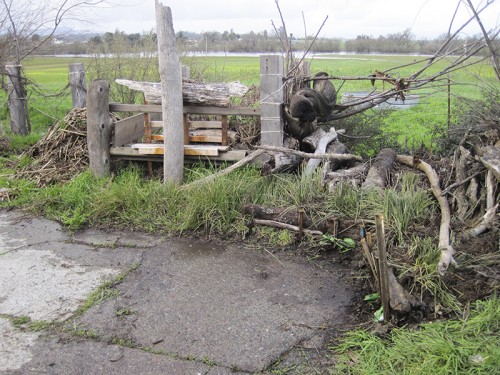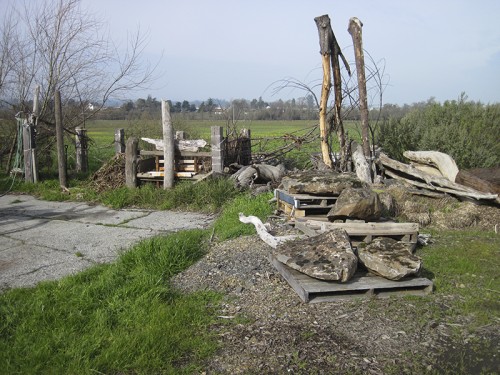 Centipede Tunnel Perch — The Before. Northwest view. Previous installations in the Habitat Garden (nearest to farthest): Cookie Monster Perch, Garter Snake Ravine, Log Pile Apartments, Compost Cricket Corral, Big Splash Hotel and Spa, and Salamander French Drain, the last of which is nearly under the willow to the left.
Centipede Tunnel Perch — The Before. Northwest view. Previous installations in the Habitat Garden (nearest to farthest): Cookie Monster Perch, Garter Snake Ravine, Log Pile Apartments, Compost Cricket Corral, Big Splash Hotel and Spa, and Salamander French Drain, the last of which is nearly under the willow to the left.
Centipede Tunnel Perch is a wildlife habitat installed near the Habitat Landscaping Resource Center (otherwise known as the “compost” and “log pile”) at the Laguna Foundation‘s Laguna Environmental Center, or LEC, located at 900 Sanford Road, Santa Rosa, California, 95401. The installation was an outdoor classroom activity. Date: January 19, 2017. School: Orchard View School, Sebastopol, California. Teacher: Sunny Galbraith. Me: Tony McGuigan, from Spore Lore.
In a nutshell, this wildlife habitat installation is 3 tasks at the Habitat Garden. The Habitat Garden can be considered the collective of wildlife habitat installations, some of which are listed under the photo, above, and all the natural (organic) materials on hand. Most of those on-hand materials are the compost and branch/log pile.
1st Task — To get a large mass of wood buried deep into the soil so it will provide moisture to critters months after the rains have gone.
2nd Task — To use the soil dug from the wood’s hole to direct water to the wood.
3rd Task — To plant native sedge to hold the soil bank downstream from Centipede Tunnel Perch.
Prep — 3 Days Before Installation
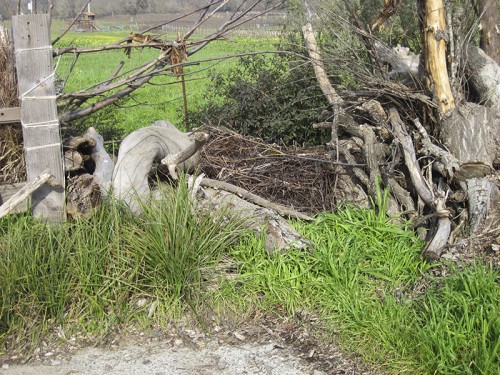 Northeast corner of concrete slab behind the Nursery. Right: Garter Snake Ravine habitat with “weeds”, mostly the alien (non-native) Italian rye grass, an annual (per the local farmer, Stuart). Left: Log Pile Apartments and Compost Critter Corral habitats and Santa Barbara sedge (Carex barbarae). The students will be sheet mulching over the weeds and planting Santa Barbara sedge to cover both sides of the slab’s corner.
Northeast corner of concrete slab behind the Nursery. Right: Garter Snake Ravine habitat with “weeds”, mostly the alien (non-native) Italian rye grass, an annual (per the local farmer, Stuart). Left: Log Pile Apartments and Compost Critter Corral habitats and Santa Barbara sedge (Carex barbarae). The students will be sheet mulching over the weeds and planting Santa Barbara sedge to cover both sides of the slab’s corner.
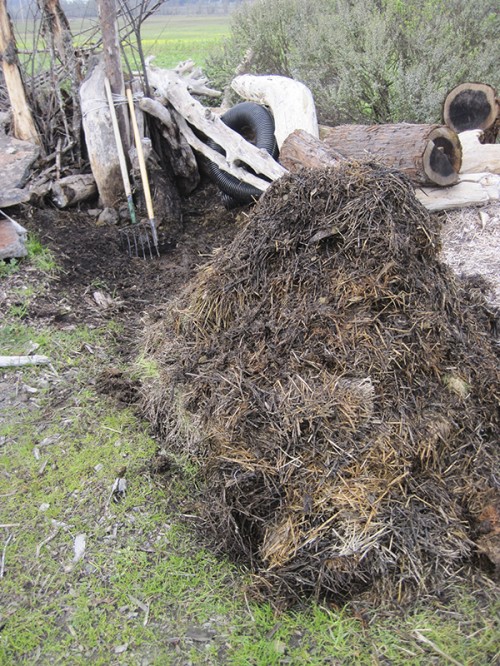 A pile of old straw is moved away to dig the deep hole for the habitat. Ultimately, a perch-like long piece of tree trunk will stand upright in the hole. The deeper the hole, the more stable the vertical post/pole will be. Also, the deeper the hole, the shorter (off the ground) the pole becomes. Grandiose towering structure VERSUS safety — always a hard weighing between the two! Note the old straw was left there to break down AND to keep the adobe clay soil moist, for digging such a hole. Wet/moisturize the dry, hard adobe clay soil one day and dig into soft, pliable adobe the next day.
A pile of old straw is moved away to dig the deep hole for the habitat. Ultimately, a perch-like long piece of tree trunk will stand upright in the hole. The deeper the hole, the more stable the vertical post/pole will be. Also, the deeper the hole, the shorter (off the ground) the pole becomes. Grandiose towering structure VERSUS safety — always a hard weighing between the two! Note the old straw was left there to break down AND to keep the adobe clay soil moist, for digging such a hole. Wet/moisturize the dry, hard adobe clay soil one day and dig into soft, pliable adobe the next day.
A further note about digging here. The digging is horrendous at this site — all the more reason to be digging here. We will be unearthing the nearby road crew’s dumping of asphalt road grading, circa 1950’s, including many book-sized slabs of asphalt. That “worthless” soil will be our new treasure in creating a berm of soil to direct rainfall to the habitat.
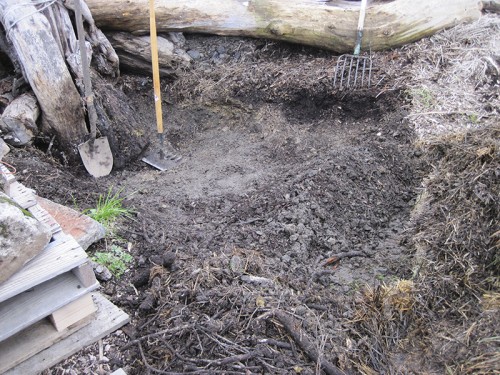 A shovel head deep into the center of the Earth. Note the straw bale far right and the little berm of hole soil between the straw and the hole. That berm will help keep rainwater (we are expecting rain on installation day) away from the area. The installation area will be slippery enough without a running creek!
A shovel head deep into the center of the Earth. Note the straw bale far right and the little berm of hole soil between the straw and the hole. That berm will help keep rainwater (we are expecting rain on installation day) away from the area. The installation area will be slippery enough without a running creek!
Prep — 2 Days Before Installation
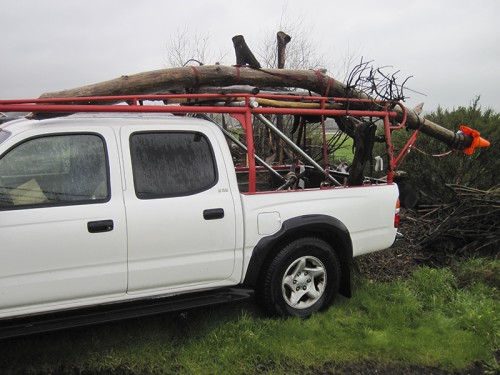 Centipede Tunnel Perch’s perch has arrived, complete with safety cone hat.
Centipede Tunnel Perch’s perch has arrived, complete with safety cone hat.
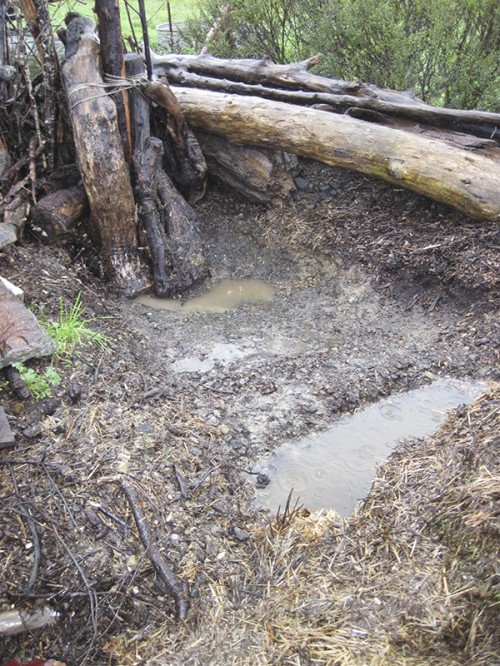 Late morning rain. Perfect time to start work. Tomorrow, this new wildlife habitat will be installed by Orchard View students. Note this microcosm canyon. Our intention here is to capture as much water as possible and store it for as long as possible, so that amphibians would thrive here. (If amphibians can thrive, most other critter groups will have a fair chance of survival, too.) So, the adobe canyon, once a road crew dump, has become an adobe-lined, wood-filled water basin with outlet.
Late morning rain. Perfect time to start work. Tomorrow, this new wildlife habitat will be installed by Orchard View students. Note this microcosm canyon. Our intention here is to capture as much water as possible and store it for as long as possible, so that amphibians would thrive here. (If amphibians can thrive, most other critter groups will have a fair chance of survival, too.) So, the adobe canyon, once a road crew dump, has become an adobe-lined, wood-filled water basin with outlet.
Regarding the habitat’s water outlet (mentioned in last paragraph), it is the height of the Santa Barbara sedge thicket, downstream from Centipede Tunnel Perch, that determines how far and wide Habitat Garden Pond becomes. Alas, a lake is born, on each good rain. As rainwater sits in the Lake, submerged wood will saturate that rainwater and store it. (Habitat Garden Adobe Canyon if you must have a name.)
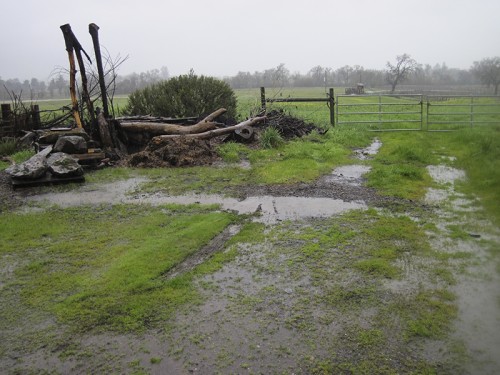 Water! Precious stuff. So, rather than allow this road runoff rainwater to escape into the field downstream, through the double gate, a small soil berm will direct the rainwater to the Habitat Garden, to then be drained behind the Nursery and flow into the field. Either way, berm or not, the downhill field will get the water. With berm keeps the gate area dryer and brings water to the Habitat Garden.
Water! Precious stuff. So, rather than allow this road runoff rainwater to escape into the field downstream, through the double gate, a small soil berm will direct the rainwater to the Habitat Garden, to then be drained behind the Nursery and flow into the field. Either way, berm or not, the downhill field will get the water. With berm keeps the gate area dryer and brings water to the Habitat Garden.
Prep — Installation Day — Before Students
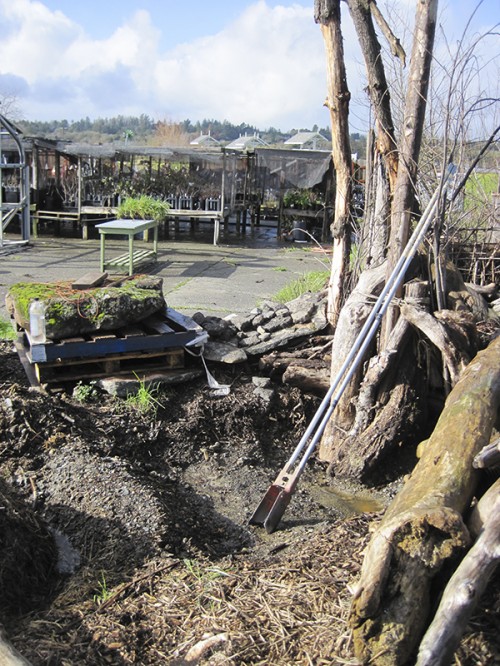 Installation Day. The soil is saturated with very little water in the hole. Perfect! I like easier digging. Note the black ABS tape on the posthole digger’s handles at 3-feet and 6-feet. The hole will be dug to the 6-feet mark.
Installation Day. The soil is saturated with very little water in the hole. Perfect! I like easier digging. Note the black ABS tape on the posthole digger’s handles at 3-feet and 6-feet. The hole will be dug to the 6-feet mark.
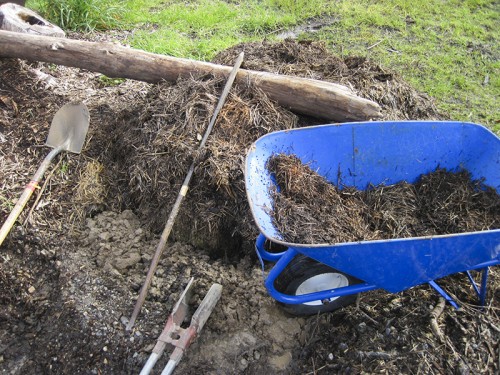 Preparing to dig. Note that the wheelbarrow is lined with straw to cleanly dump the wet adobe soil harvested from the hole. The metal digging bar will straddle across the sides of the wheelbarrow and provide a knock-off edge for clearing out the posthole digger clams. Posthole digger in foreground (clams are at collecting end).
Preparing to dig. Note that the wheelbarrow is lined with straw to cleanly dump the wet adobe soil harvested from the hole. The metal digging bar will straddle across the sides of the wheelbarrow and provide a knock-off edge for clearing out the posthole digger clams. Posthole digger in foreground (clams are at collecting end).
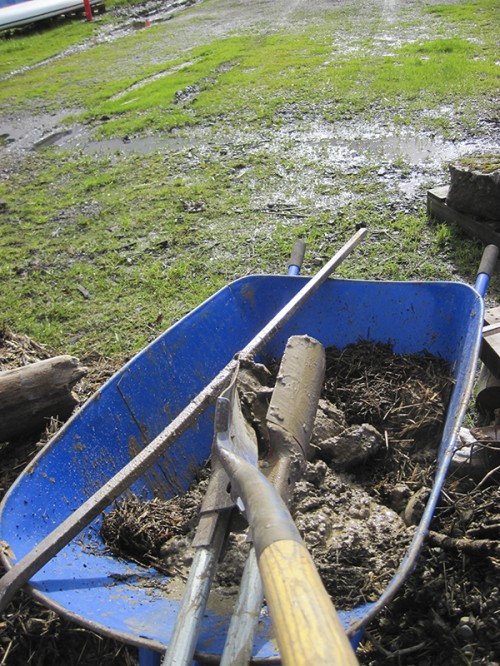 Muck removal on a bright shiny day. Note that the wood, blue-painted metal trench shovel (top) has its curve parallel with the curve of the posthole digger clam (below). The shovel will be flipped to clean the posthole digger’s right side, maintaining curve-curve parallel position. Note digging bar for banging the mud loose.
Muck removal on a bright shiny day. Note that the wood, blue-painted metal trench shovel (top) has its curve parallel with the curve of the posthole digger clam (below). The shovel will be flipped to clean the posthole digger’s right side, maintaining curve-curve parallel position. Note digging bar for banging the mud loose.
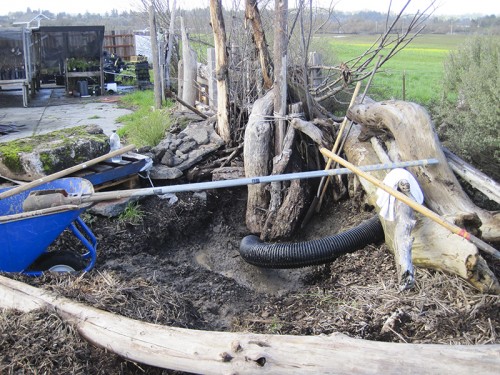 Dry Run photo op. Sizing the ABS 6″ corrugated perforated drainpipe Tunnel in the habitat.
Dry Run photo op. Sizing the ABS 6″ corrugated perforated drainpipe Tunnel in the habitat.
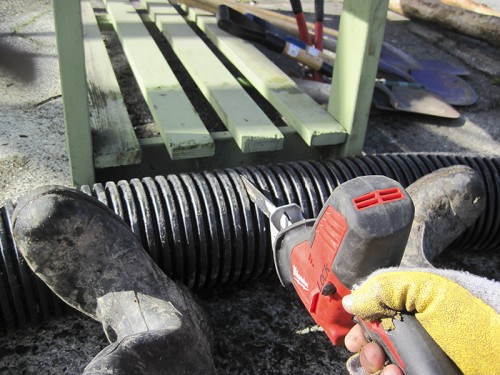 Using a Milwaukee HACKZALL® to cut the plastic corrugated perforated pipe to install Exit/Entrance’s in the tunnel. Centipede Tunnel Perch includes tenancy options for critters using it. Eat, stay, have a family here, at least take a drink of water (meets the 4 elements of Habitat), then you can enter or leave through the many Exit/Entrance’s. Each Exit/Entrance is about 6-8″ long and 2″ wide (2 corrugation trenches). Note my boots are pinning the drainpipe up against the table’s leg posts.
Using a Milwaukee HACKZALL® to cut the plastic corrugated perforated pipe to install Exit/Entrance’s in the tunnel. Centipede Tunnel Perch includes tenancy options for critters using it. Eat, stay, have a family here, at least take a drink of water (meets the 4 elements of Habitat), then you can enter or leave through the many Exit/Entrance’s. Each Exit/Entrance is about 6-8″ long and 2″ wide (2 corrugation trenches). Note my boots are pinning the drainpipe up against the table’s leg posts.
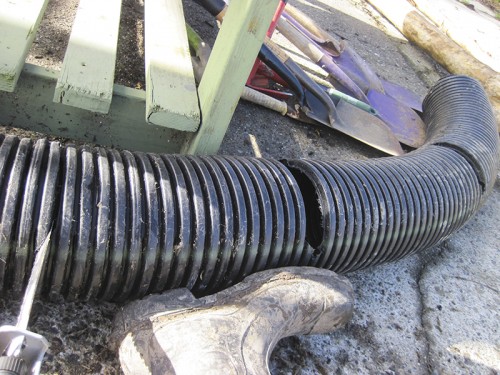 Halfway done installing Exit/Entrance’s on this side of the pipe. The pipe will then be flipped over so that Exit/Entrance’s can be cut into that side, position alternating with the first side’s Exit/Entrance’s. Note the sawblade’s angle to ensure that both long sawcuts will meet.
Halfway done installing Exit/Entrance’s on this side of the pipe. The pipe will then be flipped over so that Exit/Entrance’s can be cut into that side, position alternating with the first side’s Exit/Entrance’s. Note the sawblade’s angle to ensure that both long sawcuts will meet.
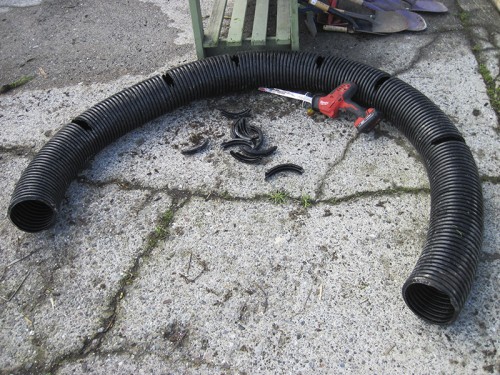 The Tunnel is ready for installation. Exit/Entrance’s cut-outs collected in center.
The Tunnel is ready for installation. Exit/Entrance’s cut-outs collected in center.
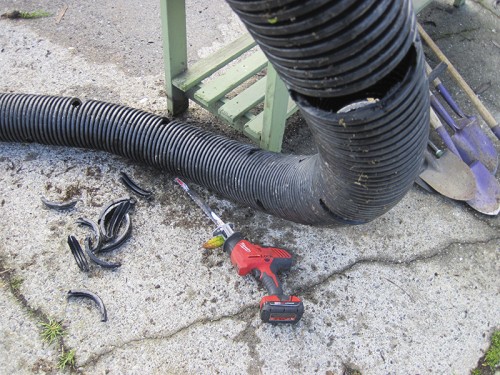 View THROUGH the Tunnel to the concrete slab below.
View THROUGH the Tunnel to the concrete slab below.
Installation Day — The Students Are Here!
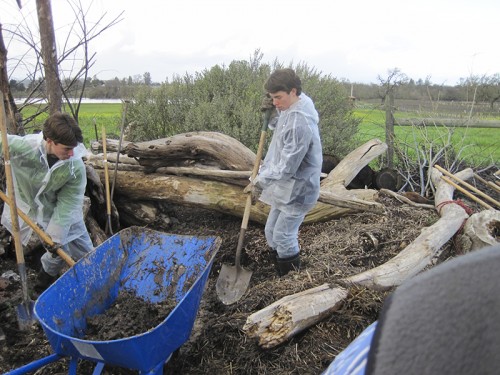 Removal of the adobe berm inside the installation zone. This soil will be the foundation for the road runoff berm.
Removal of the adobe berm inside the installation zone. This soil will be the foundation for the road runoff berm.
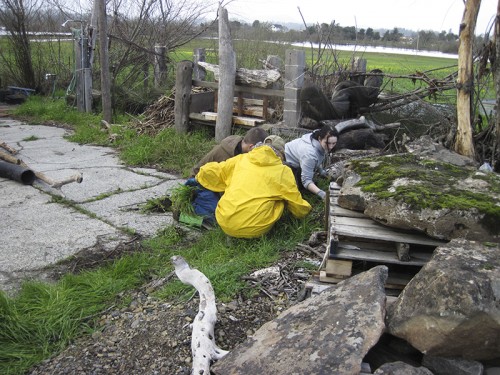 Weeding the soil bank before sheet mulching. Weeds are dropped in place to keep the topsoil nutrients/microbes on site.
Weeding the soil bank before sheet mulching. Weeds are dropped in place to keep the topsoil nutrients/microbes on site.
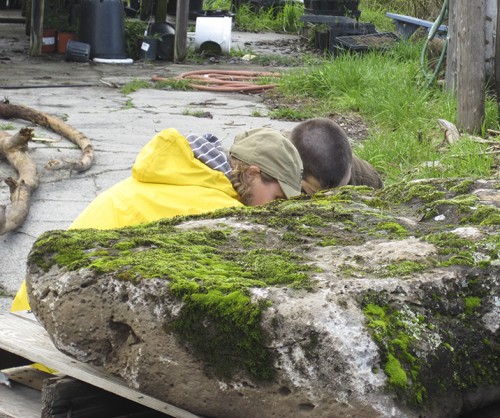 Thriving on a damp winter day. This outdoor classroom rocks! Takes a Village to support outdoor classrooms.
Thriving on a damp winter day. This outdoor classroom rocks! Takes a Village to support outdoor classrooms.
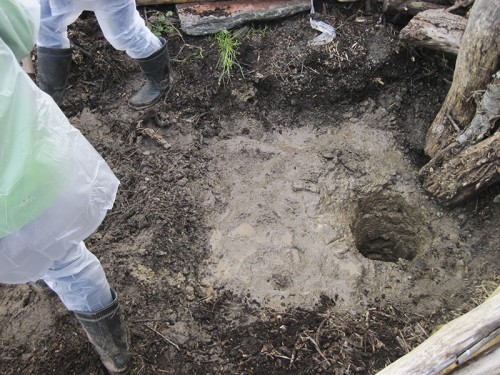 Progress of the hole. A lower platform has been stomped around the perch’s hole. That’s adobe! Note the rain workgear: mud boots and work-friendly rainsuit.
Progress of the hole. A lower platform has been stomped around the perch’s hole. That’s adobe! Note the rain workgear: mud boots and work-friendly rainsuit.
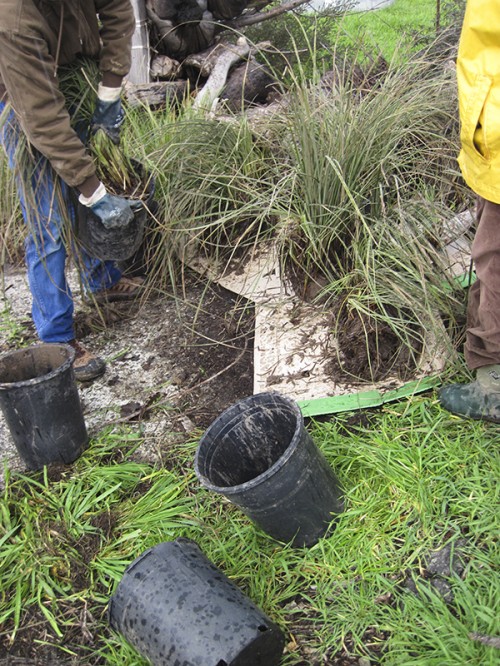 Your job (Yellow Slicker) is to stand here. And teacher Sunny did it so well while students pried Santa Barbara sedge plants from their pots. The sedge clumps were evenly spaced on the cardboard sheet mulching. Loose soil fill over the cardboard and between the plants will secure the plants in place on the bank.
Your job (Yellow Slicker) is to stand here. And teacher Sunny did it so well while students pried Santa Barbara sedge plants from their pots. The sedge clumps were evenly spaced on the cardboard sheet mulching. Loose soil fill over the cardboard and between the plants will secure the plants in place on the bank.
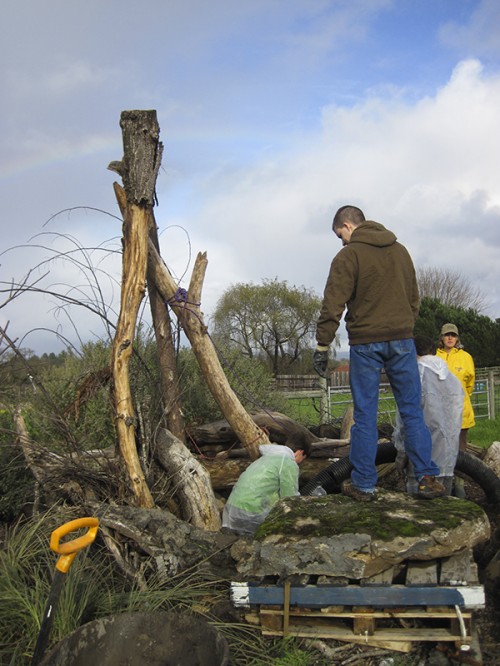 Perch has been dropped into its hole. Note the ropes hanging on Perch. A triad of ropes was used to upright the tall, heavy tree trunk. One more rope was used to spin Perch after it vertically rested in the hole.
Perch has been dropped into its hole. Note the ropes hanging on Perch. A triad of ropes was used to upright the tall, heavy tree trunk. One more rope was used to spin Perch after it vertically rested in the hole.
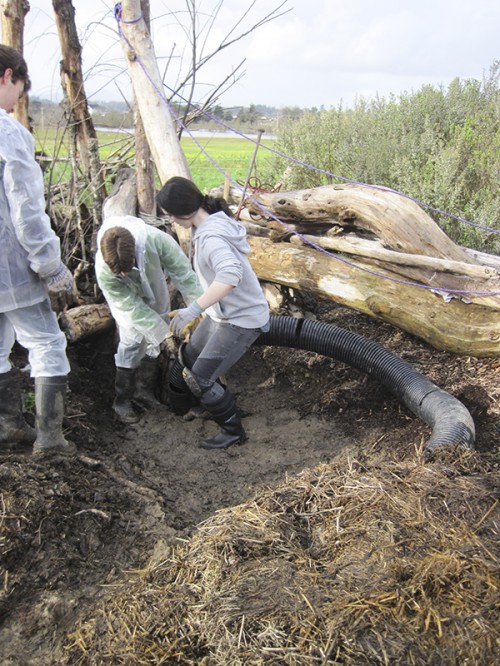 Students secure/stuff/wedge one end of Centipede Tunnel alongside Perch in the hole.
Students secure/stuff/wedge one end of Centipede Tunnel alongside Perch in the hole.
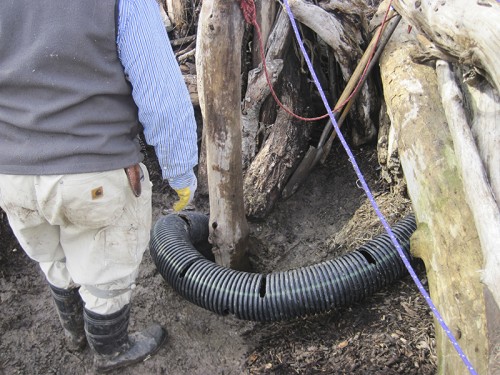 Inspection. And good news — Centipede Tunnel Perch passes. Note that the left end of Tunnel goes into the hole for Perch, toward moisture. The other end of Tunnel opens to ground level, under a log pile (or wood causeways if you are a cricket) where food (smaller critters) are plentiful.
Inspection. And good news — Centipede Tunnel Perch passes. Note that the left end of Tunnel goes into the hole for Perch, toward moisture. The other end of Tunnel opens to ground level, under a log pile (or wood causeways if you are a cricket) where food (smaller critters) are plentiful.
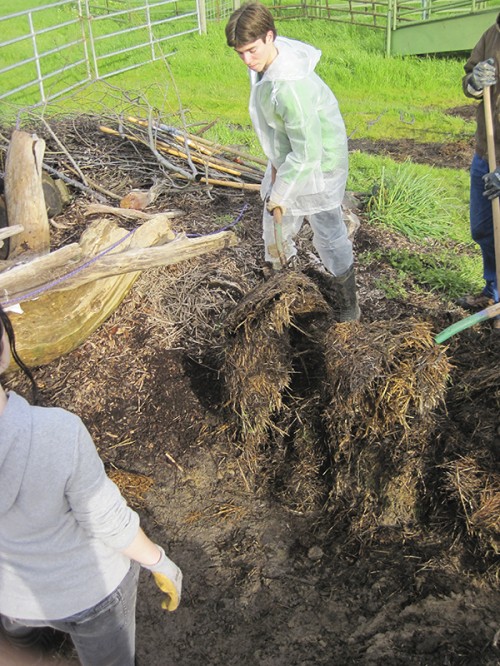 Student stands on Tunnel while it is buried with old straw.
Student stands on Tunnel while it is buried with old straw.
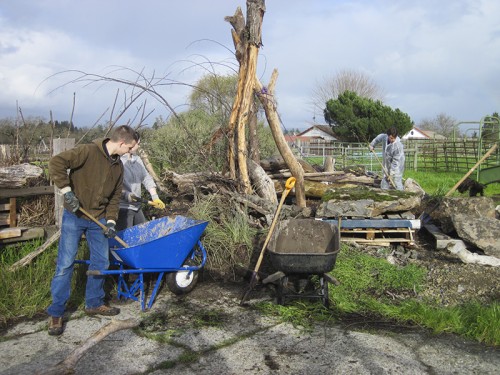 Foreground: Finishing touches for sedge transplanting — loose soil to fill in thin spots.
Foreground: Finishing touches for sedge transplanting — loose soil to fill in thin spots.
Background: Entire old straw pile is thrown at the base of Perch.
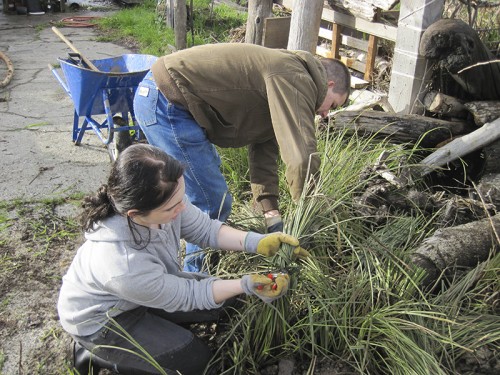 Trimming the sedge = twist and cut with pruning shears. The sedge leaves are used for mulch between the newly transplanted sedge bundles. Do plants have a feedback system such that dead leaves in the soil trigger growth? Always questions!
Trimming the sedge = twist and cut with pruning shears. The sedge leaves are used for mulch between the newly transplanted sedge bundles. Do plants have a feedback system such that dead leaves in the soil trigger growth? Always questions!
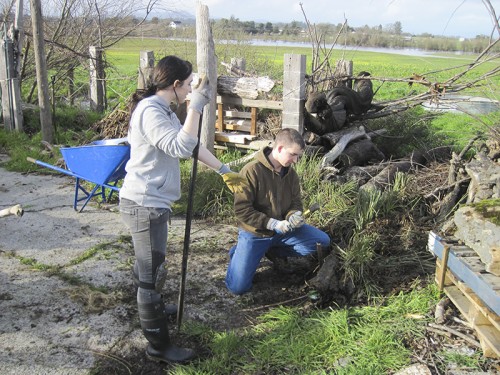 Students installing a temporary soil bank retaining wall. Short branches horizontal, saved-from-the-wood-bin stakes vertical. By the time these flimsy materials rot, like next year, the sedge bank will be glad to eat it up, glad to be nourished by the decaying wood. AND, most of that decay process will be from our Decomposer friends. Habitat it!
Students installing a temporary soil bank retaining wall. Short branches horizontal, saved-from-the-wood-bin stakes vertical. By the time these flimsy materials rot, like next year, the sedge bank will be glad to eat it up, glad to be nourished by the decaying wood. AND, most of that decay process will be from our Decomposer friends. Habitat it!
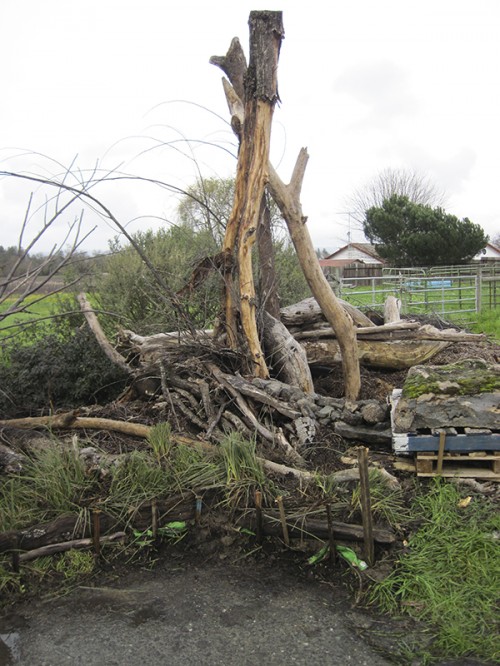 Sedge Corners. Note the tempory retaining wall of mulch material (little sticks, stakes, woodchips, soil). Perch is the blonde piece of wood on the far right of the tower of perches.
Sedge Corners. Note the tempory retaining wall of mulch material (little sticks, stakes, woodchips, soil). Perch is the blonde piece of wood on the far right of the tower of perches.
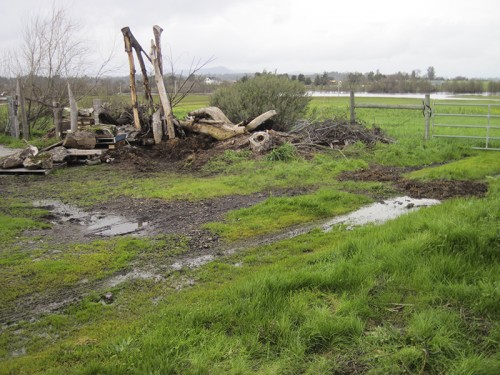 Centipede Tunnel Perch — The After. Note far right, the pooled water stopped from going to the gate by the new berm.
Centipede Tunnel Perch — The After. Note far right, the pooled water stopped from going to the gate by the new berm.
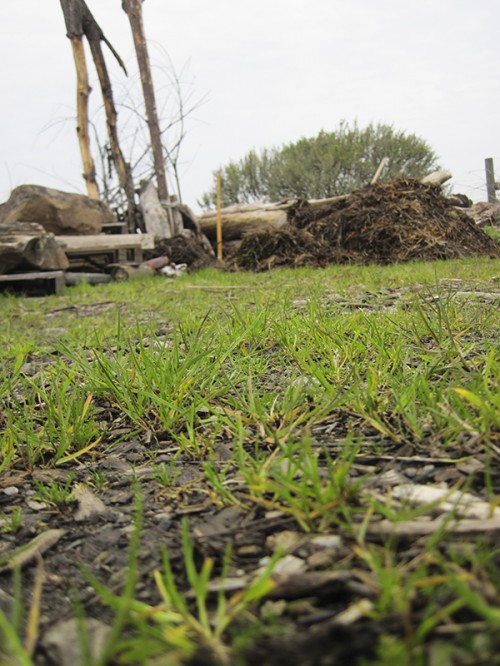 Hop, hop, and a few more. Wonder if my froggy friends will be at Habitat Garden Lake tonight?
Hop, hop, and a few more. Wonder if my froggy friends will be at Habitat Garden Lake tonight?
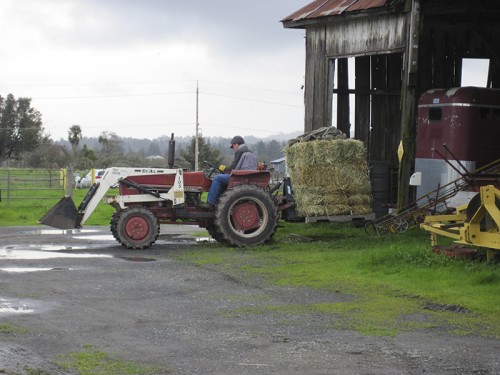 Farmer Stuart moving hay for Stone Farm‘s plow horses.
Farmer Stuart moving hay for Stone Farm‘s plow horses.
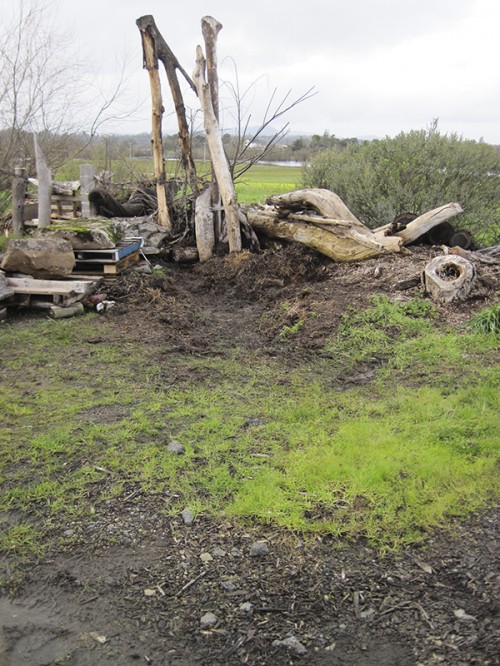 Centipede Tunnel Perch lookin’ good!
Centipede Tunnel Perch lookin’ good!
Time to call it an Outdoor Classroom Wildlife Habitat Installation Day! Time to give up the habitat to the critters. Time to go home, watch the receding Laguna de Santa Rosa leave the oak meadows along its banks.
Thank you, as always, to Sunny Galbraith, teacher at Orchard View School, Sebastopol, and her students. Also, much thanks to the Staff and Board of the Laguna Foundation, particularly the Restoration and Conservation Science Department: Wendy Trowbridge, Director; Brent Reed, Ecological Program Manager; and Paul Weber, Restoration Field Supervisor, and Julie Skopal, Nursery Manager.
Thank you to Aaron Nunez, the then Ecological Project Manager. Aaron has left the Laguna Foundation’s employment and is currently working elsewhere. Yay for Aaron! We teachers, students, and critters all appreciated his work while at the Laguna Foundation.
Enjoy your habitat installations. Habitat it!
Tony

